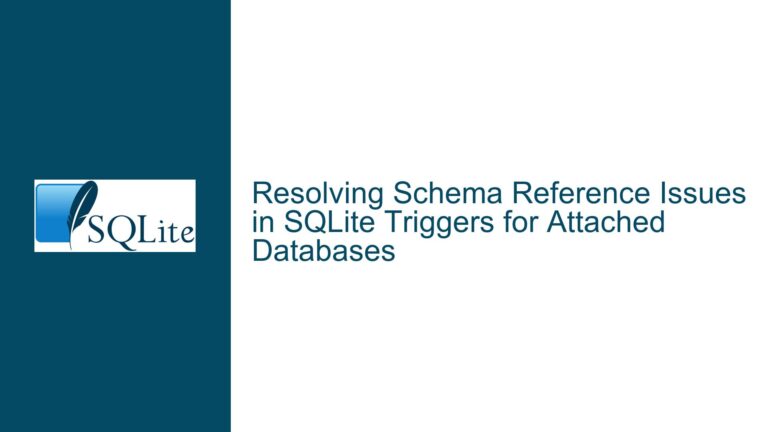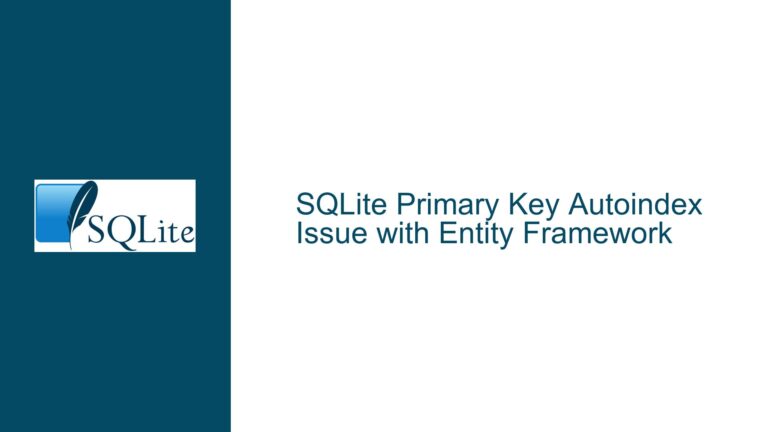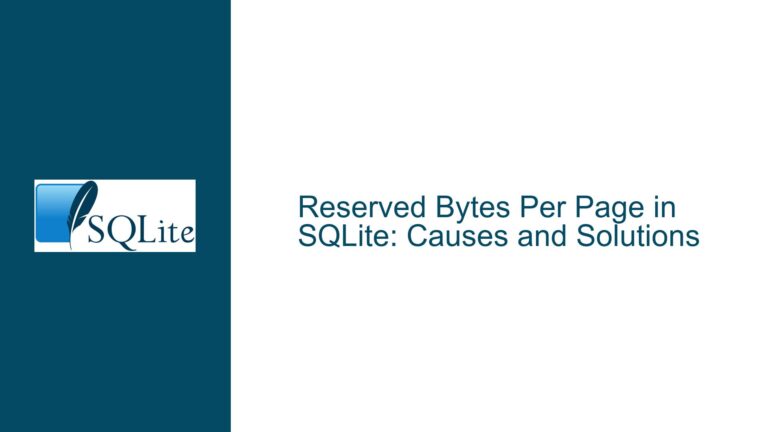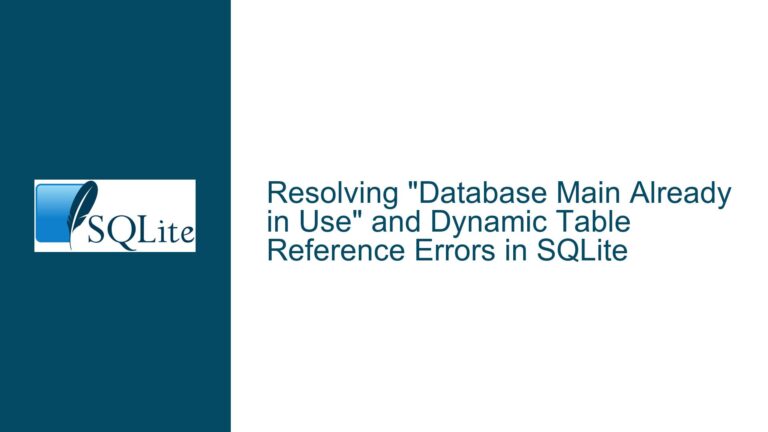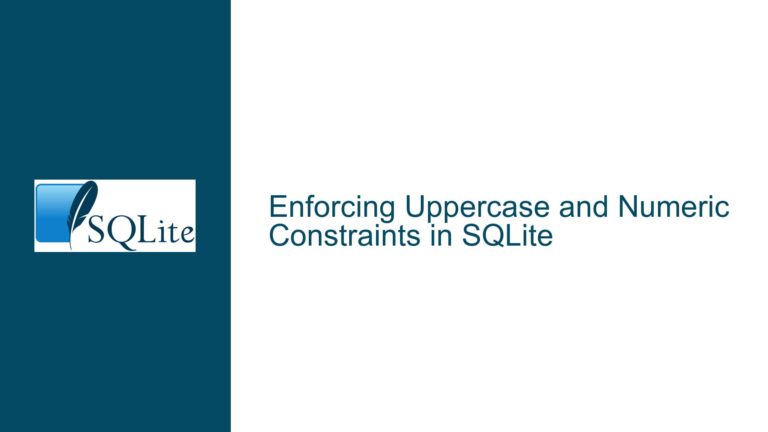Exploring SQLite’s Abstraction Limitations and Potential Solutions
SQLite’s Abstraction Gaps: Recursive CTEs, Custom Functions, and Writable Views
SQLite is a powerful, lightweight, and widely-used database engine that excels in many areas, particularly in embedded systems and applications where simplicity and portability are paramount. However, its design philosophy and scope inherently limit its abstraction capabilities, which can be a bottleneck for developers seeking advanced functionality. This post delves into the core abstraction limitations of SQLite, including the lack of recursive top-level tables, the inability to define custom SQL functions, and the challenges associated with writable views. These limitations are not merely theoretical concerns but have practical implications for developers who need to build complex, maintainable, and reusable database logic.
At its core, SQLite is designed to be a self-contained, serverless, and zero-configuration database engine. While this design makes it highly portable and easy to integrate, it also means that certain features common in more heavyweight databases, such as stored procedures, custom storage engines, and advanced procedural logic, are either absent or require workarounds. For instance, SQLite supports recursive common table expressions (CTEs), which allow for powerful recursive queries, but it does not support recursive top-level tables. Similarly, while custom functions can be added via the C API, there is no native support for defining reusable SQL functions or procedural logic directly within SQLite.
Another significant limitation is the inability to create writable views without resorting to triggers. Views in SQLite are read-only by default, and while INSTEAD OF triggers can be used to make them writable, this approach is cumbersome and lacks the elegance of native writable views. These limitations, among others, highlight the trade-offs inherent in SQLite’s design and raise important questions about how developers can work around them while maintaining the database’s simplicity and performance.
Interrupted Write Operations Leading to Index Corruption
The abstraction gaps in SQLite are not merely inconveniences; they can lead to significant challenges in real-world applications. For example, the lack of recursive top-level tables can complicate scenarios where hierarchical data structures need to be modeled and queried efficiently. Recursive CTEs provide a partial solution, but they are not a substitute for recursive tables, which would allow for more natural and maintainable data modeling.
The absence of native support for custom SQL functions is another pain point. While the C API allows developers to extend SQLite’s functionality, this approach requires significant effort and expertise, particularly for those who are not proficient in C. This limitation forces developers to either duplicate code across queries or rely on external tools and languages to achieve the desired functionality, which can introduce complexity and reduce portability.
Writable views are another area where SQLite falls short. Views are a powerful tool for abstracting complex queries and providing a simplified interface to the underlying data. However, the inability to create writable views without using INSTEAD OF triggers can lead to convoluted and error-prone code. This limitation is particularly problematic in applications where data integrity and consistency are critical, as the use of triggers can introduce subtle bugs and performance issues.
The lack of support for custom storage engines further exacerbates these challenges. While SQLite’s virtual table feature provides a mechanism for integrating external data sources, it is not a true substitute for custom storage engines. Virtual tables are inherently limited in their ability to handle complex data formats and operations, and they require significant effort to implement and maintain. This limitation can be a significant barrier for developers who need to work with non-traditional data sources, such as CSV files or Excel spreadsheets.
Implementing PRAGMA journal_mode and Database Backup Strategies
Despite these limitations, there are several strategies and techniques that developers can use to mitigate the abstraction gaps in SQLite. One of the most effective approaches is to leverage SQLite’s PRAGMA statements, particularly PRAGMA journal_mode, to enhance data integrity and performance. The journal_mode pragma controls how SQLite handles transaction logging, which can have a significant impact on both performance and reliability. For example, setting journal_mode to WAL (Write-Ahead Logging) can improve concurrency and reduce the risk of data corruption in the event of a power failure or crash.
Another important strategy is to implement robust database backup and recovery mechanisms. SQLite provides several tools and techniques for backing up databases, including the VACUUM command, which can be used to rebuild the database file and reclaim unused space. Additionally, the sqlite3_backup API provides a powerful and efficient way to create online backups of SQLite databases, which can be critical for applications that require high availability and data durability.
For developers who need to work around the lack of custom SQL functions, one approach is to use views with INSTEAD OF triggers to simulate stored procedures. While this approach is not as elegant as native support for stored procedures, it can provide a reasonable workaround for many use cases. Similarly, the use of recursive CTEs can help mitigate the lack of recursive top-level tables, although it requires careful design and testing to ensure that the resulting queries are efficient and maintainable.
In cases where virtual tables are not sufficient, developers can consider using external tools and libraries to preprocess and transform data before loading it into SQLite. For example, tools like pandas in Python can be used to manipulate CSV files and Excel spreadsheets, and the resulting data can then be imported into SQLite for further analysis and querying. While this approach introduces additional complexity, it can provide a more flexible and powerful solution for working with non-traditional data sources.
Finally, developers should consider the trade-offs involved in extending SQLite’s functionality through the C API. While this approach can provide significant flexibility and power, it also requires a deep understanding of SQLite’s internals and can introduce additional complexity and maintenance overhead. In many cases, it may be more practical to use a combination of SQLite’s built-in features and external tools to achieve the desired functionality, rather than attempting to extend SQLite itself.
In conclusion, while SQLite’s abstraction limitations can pose significant challenges, they are not insurmountable. By leveraging SQLite’s existing features, implementing robust backup and recovery strategies, and using external tools and libraries where necessary, developers can overcome these limitations and build powerful, maintainable, and reliable applications. However, it is important to carefully consider the trade-offs involved in each approach and to choose the solution that best meets the needs of the specific application and development team.

